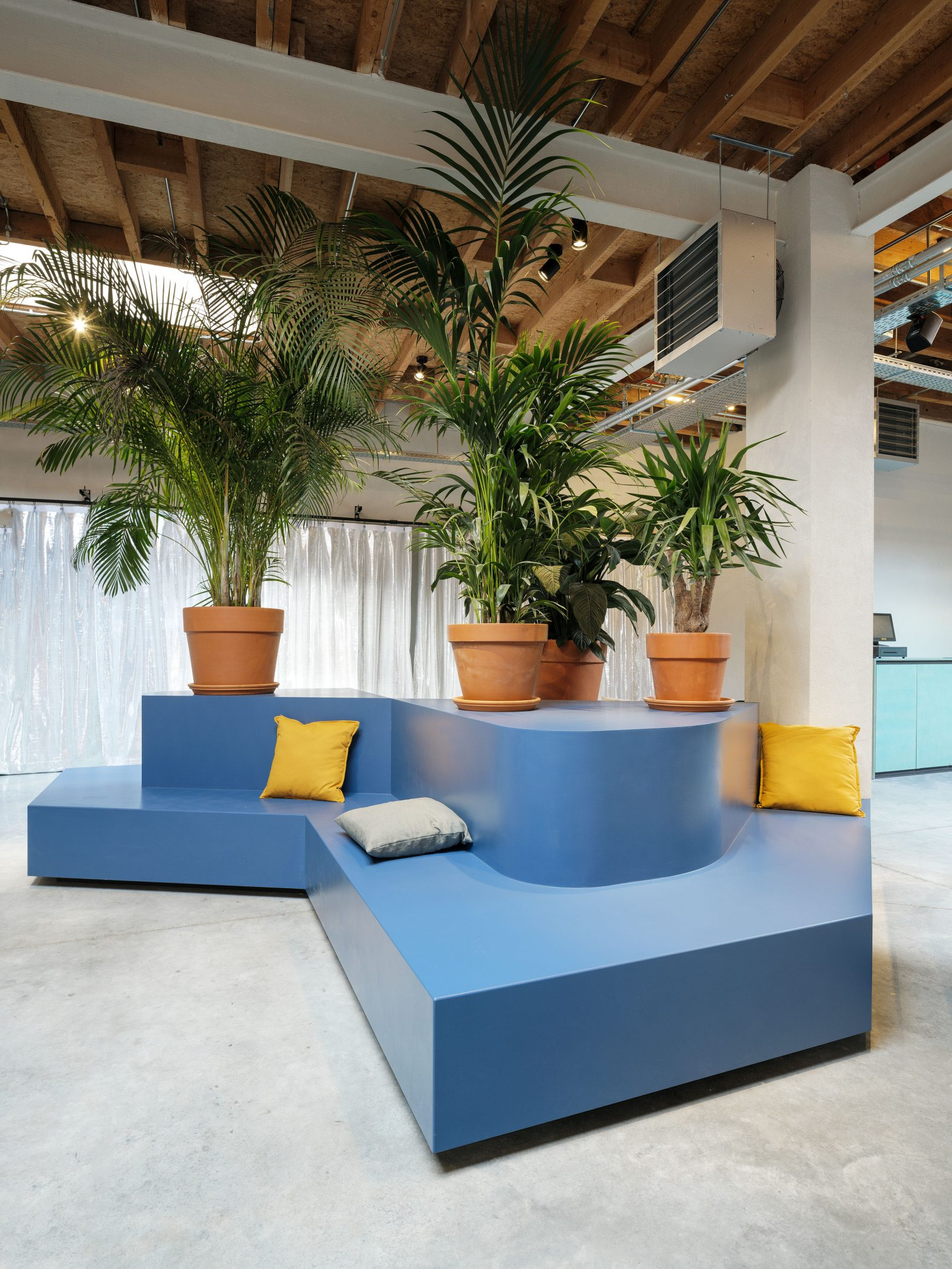AMOR - A restaurant for the ROMA
![]()
![]()


AMOR is a bar and restaurant interior that we designed in
collaboration with Michiel Thys (with whom we worked before
for cafés Walvis and Vitrin). De Roma called in Michiel Thys as
consultant and designer for the total concept, after which he approached us for the architecture and interior design.
From the start, the vastness of the existing space posed a challenge. To tame this vastness, we relied on several strategies to help us structure, define, and finally coax it into its new form and function.
A first step was to divide the space into two parts, a bar
in the front and a restaurant in the back The bar volume (THE BOOMERANG) acts as an interlocutor separating the two functions. The design and materiality express this dual role. Returnin elements and materials ensure continuity, while the differentiation in design emphasizes the intrinsically different character of both parts.
collaboration with Michiel Thys (with whom we worked before
for cafés Walvis and Vitrin). De Roma called in Michiel Thys as
consultant and designer for the total concept, after which he approached us for the architecture and interior design.
From the start, the vastness of the existing space posed a challenge. To tame this vastness, we relied on several strategies to help us structure, define, and finally coax it into its new form and function.
A first step was to divide the space into two parts, a bar
in the front and a restaurant in the back The bar volume (THE BOOMERANG) acts as an interlocutor separating the two functions. The design and materiality express this dual role. Returnin elements and materials ensure continuity, while the differentiation in design emphasizes the intrinsically different character of both parts.

The rear part, where the restaurant is situated, consists of an abundant space with lots of daylight, of which the darkest zone with the lowest ceiling height became the kitchen and storage. We kept the existing wooden structural ceiling in its original state to maintain a maximum height and kept the wood to emphasize the difference in atmosphere. We put wooden frames in the skylight openings to accentuate them as a light source.


The front part, the bar, consists of a series of interconnected
spaces. The first two rooms occupy the entire width of the building and, together with the central bar, form an L-shape. A fixed bench (THE SHARKTOOTH BENCH) creates a unique dynamism and intimacy.
spaces. The first two rooms occupy the entire width of the building and, together with the central bar, form an L-shape. A fixed bench (THE SHARKTOOTH BENCH) creates a unique dynamism and intimacy.


Along the right and back wall, we introduced a fixed
bench (THE FILET) related to the bench in the bar area, but with a
much lighter base: a row of slender legs at the front, supplemented by a wall mounting at the rear. In the corner, a mirror-polished stainless steel flanks the back of the sofa.
bench (THE FILET) related to the bench in the bar area, but with a
much lighter base: a row of slender legs at the front, supplemented by a wall mounting at the rear. In the corner, a mirror-polished stainless steel flanks the back of the sofa.


Individual furniture sculptures (THE ISLANDS) divide the hug space in the middle and offer more intimate seating, buffered by plants.
Three floor-to-ceiling curtains act as a colourful backdrop.
A silver curtain can separate the restaurant from the bar. Two
dark green velvet curtains can disguise the kitchen wall and
create a partition between the central bar and the space in front,
at smaller events.
We used the same chairs for the bar and restaurant area tables, but with a different finish: marble tabletops and green chairs for the bar, black MDF tabletops and black chairs in front of the restaurant.
Three floor-to-ceiling curtains act as a colourful backdrop.
A silver curtain can separate the restaurant from the bar. Two
dark green velvet curtains can disguise the kitchen wall and
create a partition between the central bar and the space in front,
at smaller events.
We used the same chairs for the bar and restaurant area tables, but with a different finish: marble tabletops and green chairs for the bar, black MDF tabletops and black chairs in front of the restaurant.


The fourth space is, as it were, a corridor and works as a transition space between the bar and the restaurant and the toilets. Where a hall is often an underutilized functional space, it fulfils a double function as a peninsula towards the bar. The sofa of the adjacent space runs through the wall opening and crosses into the hallway (THE LIP). The visual connection encourages visitors to walk along the central bar volume to find their way back.




The fourth space is, as it were, a corridor and works as a transition space between the bar and the restaurant and the toilets. Where a hall is often an underutilized functional space, here it fulfils a double function as a peninsula towards the bar. The sofa of the adjacent space runs through the wall opening and crosses into the hallway (THE LIP). The visual connection encourages visitors to walk along the central bar volume to find their way back.
Location Antwerp(BE)
completion 2019
client De Roma
program interior design of restaurant and bar
architecture unknown
interior architecture i.s.m.architecten i.c.w. Michiel Thys
photographs Luis Dìaz Dìaz